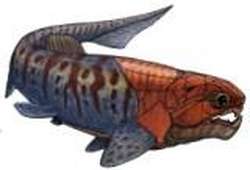Fossilised pregnant fish was one of the first animals to have sex

(PhysOrg.com) -- A pregnant fossil fish at the Natural History Museum in London has shed light on the possible origin of sex, according to a study published in Nature today by an international team including Museum scientists. The fossil is an adult placoderm, an extinct group of armoured fish, and it contains a 5cm-long embryo. It is dated to the Upper Devonian period 350 million years ago and was found in the Gogo formation of western Australia.
The fish species is Incisoscutum ritchiei and this specimen is one of the earliest examples of a pregnant vertebrate and shows that internal fertilisation, or sex, started far sooner than previously thought.
‘This discovery is incredibly important because evidence of reproductive biology is extremely rare in the fossil record,’ says Dr Zerina Johanson, fossil expert (palaeontologist) at the Natural History Museum.
External fertilisation is believed to be the earliest form of reproduction and scientists used to think the placoderms and other early fish groups used this method. ‘We expected that these early fishes would show a more primitive type of reproduction, where sperm and eggs combine in the water and embryos develop outside the fish,’ says Dr Johanson.
The process of internal fertilisation and giving birth to live young, or viviparity, is more advanced and differentiates some fish and mammals from other animals such as reptiles and amphibians.
Johanson and her colleagues believe it was the main reproductive method for early fish groups such as the placoderms and could have evolved in other fish groups.
‘Sex was far more common in these primitive prehistoric animals,’ adds Dr Johanson. ‘However, copulation appears to be the main way they reproduced, demonstrating that ‘sex’ started a lot sooner than we thought.’
The fish fossil has been in the Museum collections since the 1980s. Along with thousands of other fish specimens, they are used in scientific study by Museum scientists and other researchers from around the world.
The Incisoscutum ritchiei fish specimen was originally thought to have died soon after its final meal, because the bones of a smaller can be fish seen within it.
However, recent findings such as embryos found in other placoderms, caused Johanson and her colleagues to take another look at the fossil.
‘The position of the embryo in this fish is the same as that of another found with a placoderm embryo in it in 2008.’ So they decided to reassess the description for the Incisoscutum ritchiei fossil.
The team came to the conclusion that the ‘meal’ was in fact a young fish developing in the womb of an adult.
‘The embryo in Incisoscutum ritchiei was in its final stages of development, inside its mother, waiting to be born,’ continues Dr Johanson.
‘This specimen shows just how important the Museum collections are because knowledge evolves and we have new interpretations that we can apply to fossils in the collections.'
A modification of the pelvic fin on the belly of the adult fish is also significant. This structure, or clasper, would have been used by the male to grip the female during mating.
Placoderms were a diverse group of prehistoric fish. Their head and thorax were covered by articulated armoured plates and the rest of the body had scales or was naked, depending on the species.
Thought to be the most primitive jawed vertebrates, placoderms were the dominant vertebrate group during the Devonian period.
It was thought they went extinct due to competition from the first bony fish and early sharks.
But now research has shown that the last placoderms died out one by one as each of their ecological communities suffered the environmental catastrophes of the Devonian/Carboniferous extinction event.
More information: Devonian Arthrodire Embryos and the Origin of Internal Fertilisation in Vertebrates is published in the journal Nature 26 Feb 2009 vol 457 issue 7233 pp 1124-1127
Provided by Natural History Museum

















